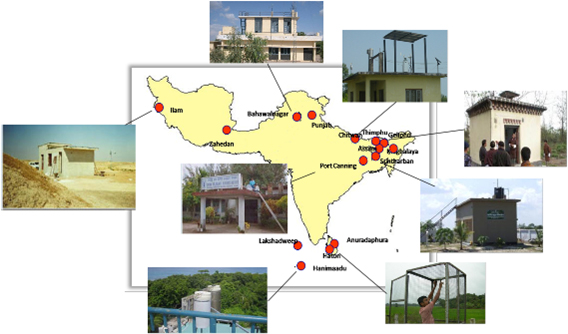
A large part of the effort during the implementation of the Malé Declaration has been the development, at the request of the governments, of regionally representative monitoring that can contribute to the understanding of trends in pollution and the degree of transboundary transport of air pollution in the region. The main aim has been to strengthen the monitoring capacities of the countries based on common methodologies and protocols and develop a network. There is now at least one monitoring station in each country in more remote, regionally representative, sites which is being used to provide data on levels and trends of air pollution and validate the results of the atmospheric transport models (see next section).
In all countries there were no regionally representative monitoring sites prior to the implementation of the Malé Declaration network nor was there capacity to run them and analyse results. The sustainability of the network is enhanced by the fact that the sites are run by the governments. In Phase III existing Malé monitoring sites were maintained and audited by the Malé Declaration Monitoring Committee (MoC) and in some cases upgraded. Training has been provided to the practitioners looking after the sites to promote high quality monitoring and they have participated in Quality Assessment and Quality Control (QA/QC) exercises; the third Inter – Laboratory Comparison of Precipitation Chemistry Analyses among the NIAs of the Malé Declaration was completed in 2011.
Malé Declaration achievements and results
- Monitoring is the backbone of all other activities and must be stable and long-term and organized in a robust network of monitoring sites. The Malé Monitoring Network was established in 2003 with at least one regional monitoring site established in each of the 8 Malé Declaration countries, further sites have subsequently been added in Bhutan, India, Iran, Maldives and Sri Lanka and there are currently 15 sites in the network;
- Monitoring data has been regularly reported to the Malé Declaration Secretariat for almost 10 years, consisting of: monthly passive sampler (IVL, Sweden) measurements of air concentrations of sulphur dioxide (SO2), nitrogen dioxide (NO2) and Ozone (O3); rain chemistry including pH and electrical conductivity measurements and ionic composition of rain conducted by the Malé Declaration; measurement of airborne particulate matter; plus some meteorological measurements;
- The passive sampler network has shown strong seasonal trends in the air concentrations of the three gases measured, with significant increases over time in mean annual concentrations of SO2 (Bangladesh, Bhutan, Nepal and Sri Lanka), NO2 (Bangladesh, Bhutan, Maldives, Nepal and Sri Lanka) and O3 (Bangladesh, Bhutan, Maldives and Sri Lanka).
- Regular training and capacity building workshops have taken place, with India taking an active role in the training;
- Quality control and assurance procedures with training have been conducted for the Malé Declaration sites, three reports on Inter – Laboratory Comparison of Precipitation Chemistry Analyses among the National Implementation Agencies (NIAs) of the Malé Declaration have been compiled;
- A regional centre on monitoring activities is being established in India
